Dynamic Analysis and Energy Harvesting Potential of Slitted Cantilever Beam Fitted with Piezoelectric Transducer
Abstract
:1. Introduction
2. Electromechanical Model
3. Results
3.1. Finite Element Analysis (FEA)
3.2. Comparison of FEA and Analytical Models
3.3. Effect of Slit Parameters on Beam Dynamics
3.4. Impact of Varying Single Tip Mass on Frequency Response of Slitted Beam
3.5. Influence of Slit Width on Frequency Response of Slitted Beams
3.6. Effect of Slit Distance on the Frequency Response of Slitted Beams
4. Conclusions
- Impact of Slit Length: Resonance peaks are brought closer together by decreasing the slit length, which improves the coupling between vibrational modes. At larger slit lengths, the response becomes closer to that of a conventional beam without a slit, confirming that the best possible slit placement is essential to achieving maximum energy harvesting efficiency.
- Influence of Slit Width: Changes in the slit width have an impact on the resonance peaks’ amplitude and the existence of anti-resonance dips. While larger slits make anti-resonance dips more prominent, narrower slits show higher peak amplitudes, suggesting better potential for energy harvesting.
- Tip Mass Effects: Adding tip mass on one side of the beam shifts the resonance peaks and increases their amplitudes, strengthening the energy harvesting capability. Tip mass optimization can greatly enhance dynamic response and performance, as the anti-resonance effects seen between main resonance peaks become less pronounced with increasing tip mass.
- Validation using Finite Element Analysis: The main resonance frequencies are remarkably consistent between the analytical and FEA results. The FEA model provides a more comprehensive assessment of the beam’s dynamic behaviour, accounting for extra complexity, including secondary peaks and anti-resonance troughs.
- Future Work: Optimizing slit geometry further to improve the dynamic response and energy harvesting capability of the slitted beam could be the main emphasis of further work. Deeper understanding of the mode coupling effects and anti-resonance behaviours can come from parametric research altering the number of slits, their orientations, and their forms. Furthermore, key performance indices like energy efficiency and power density are crucial for optimizing slitted beams. Future work should focus on improving these through optimized slit geometries and materials. Furthermore, future work should investigate nonlinear dynamics and their effects on energy collecting efficiency, especially for uses in low-frequency situations. Furthermore, further investigations for self-tuning slitted beams that can adjust to different frequencies for more general and effective energy capture should consider the incorporation of smart materials, like shape memory alloys. Finally, the experimental validation of these cutting-edge designs in real-world environments would offer useful information for slitted beam energy harvesters’ scaling-up for pragmatic uses.
Author Contributions
Funding
Institutional Review Board Statement
Informed Consent Statement
Data Availability Statement
Conflicts of Interest
Nomenclature
| b | Width of the Piezoelectric Layer | Greek letters | |
| c | Stiffness | Permittivity | |
| ca | External (air) Damping Coefficients | θ | Piezoelectric Coupling |
| csI | Internal Strain Rate | θeff | Modified coupling |
| D | Electric Displacement | Location of the Piezoelectric Layer | |
| Piezoelectric Strain Constant | λ | Natural Frequency | |
| e | Piezoelectric Stress | Mechanical Damping | |
| E | Electric Field | Undamped Modal Frequency | |
| Young’s modulus | Dimensionless Frequency Number | ||
| Thickness | ηr | Modal Coordinate of a Clamped-Free beam | |
| Current | Orthonormal Mode Shape | ||
| m | Mass Per Unit Length | ||
| Moment | Superscripts | ||
| Number of Slits | Effective | ||
| Power Modulus | L | Load | |
| Resistance | p | Piezoelectric Layer | |
| Mechanical Strain | r | Ratio | |
| T | Mechanical Stress | ||
| Circuit Time Constant | Abbreviations | ||
| Voltage | FEA | Finite Element Analysis | |
| w | Displacement | FEM | Finite Element Method |
| Base Motion | FRF | Frequency Response Function | |
| Relative Transverse Displacement | MEMS | Microelectromechanical | |
| Width of each Slit | PDMS | Polydimethylsiloxane | |
| Modal Coupling | PVDF | Polyvinylidene Fluoride | |
| YI | Bending Stiffness | PZT | Piezoelectric Transducer |
| z | Distance | ||
References
- Rigo, F.; Migliorini, M.; Pozzebon, A. Piezoelectric Sensors as Energy Harvesters for Ultra Low-Power IoT Applications. Sensors 2024, 24, 2587. [Google Scholar] [CrossRef] [PubMed]
- Luis Alconero, P.; Antonio Islas-Herrera, M.; Sánchez-Luna, D.; Miguel Jaimes-Ponce, J.; Andrés Córdova-Córdova, D.; Iván Lorenzo-Alfaro, C.; Hernández-Rivera, D. Energy Harvester Based on Mechanical Impacts of an Oscillating Rod on Piezoelectric Transducers. Clean Technol. 2024, 6, 907–920. [Google Scholar] [CrossRef]
- Sobianin, I.; Psoma, S.D.; Tourlidakis, A. A 3D-Printed Piezoelectric Microdevice for Human Energy Harvesting for Wearable Biosensors. Micromachines 2024, 15, 118. [Google Scholar] [CrossRef]
- Pracucci, A.; Vandi, L.; Belletti, F.; Melo, A.R.A.; Vlachos, M.; Amditis, A.; Calcagni, M.T.; Esteves, D.S. Integration of Piezoelectric Energy Harvesting Systems into Building Envelopes for Structural Health Monitoring with Fiber Optic Sensing Technology. Energies 2024, 17, 1789. [Google Scholar] [CrossRef]
- Wakshume, D.G.; Płaczek, M.Ł. Optimizing Piezoelectric Energy Harvesting from Mechanical Vibration for Electrical Efficiency: A Comprehensive Review. Electronics 2024, 13, 987. [Google Scholar] [CrossRef]
- Wang, Z.L.; Song, J. Piezoelectric Nanogenerators Based on Zinc Oxide Nanowire Arrays. Science 2006, 312, 242–246. [Google Scholar] [CrossRef]
- He, X.; Li, D.; Zhou, H.; Hui, X.; Mu, X. Theoretical and Experimental Studies on Mems Variable Cross-Section Cantilever Beam Based Piezoelectric Vibration Energy Harvester. Micromachines 2021, 12, 772. [Google Scholar] [CrossRef]
- Xue, S.; Lian, P.; Wang, Y.; Prashad, L.; Chandra Mohanta, H.; Mohamed, H.G. A Compact Circular Rectenna for RF-Energy Harvesting at ISM Band. Micromachines 2023, 14, 825. [Google Scholar] [CrossRef]
- Yu, H.; Zhang, X.; Shan, X.; Hu, L.; Zhang, X.; Hou, C.; Xie, T. A Novel Bird-Shape Broadband Piezoelectric Energy Harvester for Low Frequency Vibrations. Micromachines 2023, 14, 421. [Google Scholar] [CrossRef] [PubMed]
- Hossain, M.J.; Rahman, M.H.; Faruque, M.R.I. An Innovative Polarisation-Insensitive Perfect Metamaterial Absorber with an Octagonal-Shaped Resonator for Energy Harvesting at Visible Spectra. Nanomaterials 2023, 13, 1882. [Google Scholar] [CrossRef] [PubMed]
- Zheng, J.; Li, Z.; Zhang, H.; Zheng, J.; Li, Z.; Zhang, H. Low-Wind-Speed Galloping Wind Energy Harvester Based on a W-Shaped Bluff Body. Energies 2024, 17, 958. [Google Scholar] [CrossRef]
- Zhang, G.; Gao, S.; Liu, H.; Niu, S. A Low Frequency Piezoelectric Energy Harvester with Trapezoidal Cantilever Beam: Theory and Experiment. Microsyst. Technol. 2017, 23, 3457–3466. [Google Scholar] [CrossRef]
- Chimeh, H.E.; Nabavi, S.; Janaideh, M.A.; Zhang, L. Deep-Learning-Based Optimization for a Low-Frequency Piezoelectric MEMS Energy Harvester. IEEE Sens. J. 2021, 21, 21330–21341. [Google Scholar] [CrossRef]
- D’Ambrogio, G.; Zahhaf, O.; Le, M.Q.; Capsal, J.F.; Cottinet, P.J. Dielectrophoresis Structurization of PZT/PDMS Micro-Composite for Elastronic Function: Towards Dielectric and Piezoelectric Enhancement. Materials 2021, 14, 4071. [Google Scholar] [CrossRef]
- Iqbal, M.; Nauman, M.M.; Khan, F.U.; Abas, P.E.; Cheok, Q.; Iqbal, A.; Aissa, B. Multimodal Hybrid Piezoelectric-Electromagnetic Insole Energy Harvester Using PVDF Generators. Electronics 2020, 9, 635. [Google Scholar] [CrossRef]
- Toledo, J.; Ruiz-Díez, V.; Díaz, A.; Ruiz, D.; Donoso, A.; Bellido, J.C.; Wistrela, E.; Kucera, M.; Schmid, U.; Hernando-García, J.; et al. Design and Characterization of In-Plane Piezoelectric Microactuators. Actuators 2017, 6, 19. [Google Scholar] [CrossRef]
- Díaz-Molina, A.; Hernando-Garća, J.; Sánchez-Rojas, J.L. Performance Analysis of In-Plane Piezoelectric Unimorph Microactuators Based on Silicon and Polymer Substrates. J. Phys. Conf. Ser. 2017, 922, 012021. [Google Scholar] [CrossRef]
- Stamatellou, A.M. PZT and PVDF Piezoelectric Transducers’ Design Implications on Their Efficiency and Energy Harvesting Potential. Energy Harvest. Syst. 2023, 10, 157–167. [Google Scholar] [CrossRef]
- Digregorio, G.; Redouté, J.M. Electromagnetic Energy Harvester Targeting Wearable and Biomedical Applications. Sensors 2024, 24, 2311. [Google Scholar] [CrossRef]
- Lo Monaco, M.; Russo, C.; Somà, A. Identification Procedure for Design Optimization of Gravitational Electromagnetic Energy Harvesters. Appl. Sci. 2023, 13, 2736. [Google Scholar] [CrossRef]
- Kecik, K.; Stezycka, E. Nonlinear Dynamics and Energy Harvesting of a Two-Degrees-of-Freedom Electromagnetic Energy Harvester near the Primary and Secondary Resonances. Appl. Sci. 2023, 13, 7613. [Google Scholar] [CrossRef]
- Sabat, W.; Klepacki, D.; Kamuda, K.; Kuryło, K.; Jankowski-Mihułowicz, P. Efficiency Measurements of Energy Harvesting from Electromagnetic Environment for Selected Harvester Systems. Electronics 2023, 12, 4247. [Google Scholar] [CrossRef]
- El-hami, M.; Glynne-Jones, P.; White, N.M.; Hill, M.; Beeby, S.; James, E.; Brown, A.D.; Ross, J.N. Design and Fabrication of a New Vibration-Based Electromechanical Power Generator. Sens. Actuators A Phys. 2001, 92, 335–342. [Google Scholar] [CrossRef]
- Liu, C.; Chen, L.; Lee, H.P.; Yang, Y.; Zhang, X. A Review of the Inerter and Inerter-Based Vibration Isolation: Theory, Devices, and Applications. J. Frankl. Inst. 2022, 359, 7677–7707. [Google Scholar] [CrossRef]
- Zhai, L.; Gao, L.; Wang, Z.; Dai, K.; Wu, S.; Mu, X. An Energy Harvester Coupled with a Triboelectric Mechanism and Electrostatic Mechanism for Biomechanical Energy Harvesting. Nanomaterials 2022, 12, 933. [Google Scholar] [CrossRef]
- Zhang, C.; Kuang, Y.; Wang, L.; Yang, Y.; Le, X.; Guo, X.; Lee, C. Evolution of Micro-Nano Energy Harvesting Technology—Scavenging Energy from Diverse Sources towards Self-Sustained Micro/Nano Systems. Nanoenergy Adv. 2023, 3, 101–125. [Google Scholar] [CrossRef]
- Salem, M.S.; Zekry, A.; Abouelatta, M.; Shaker, A.; Salem, M.S.; Gontrand, C.; Saeed, A. Boosting the Electrostatic MEMS Converter Output Power by Applying Three Effective Performance-Enhancing Techniques. Micromachines 2023, 14, 485. [Google Scholar] [CrossRef] [PubMed]
- Meninger, S.; Mur-Miranda, J.O.; Amirtharajah, R.; Chandrakasan, A.P.; Lang, J.H. Vibration-to-Electric Energy Conversion. IEEE Trans. Very Large Scale Integr. VLSI Syst. 2001, 9, 64–76. [Google Scholar] [CrossRef]
- Othman, A.; Hrad, J.; Hajek, J.; Maga, D. Control Strategies of Hybrid Energy Harvesting—A Survey. Sustainability 2022, 14, 16670. [Google Scholar] [CrossRef]
- Wang, Y.; Wang, N.; Cao, X. From Triboelectric Nanogenerator to Hybrid Energy Harvesters: A Review on the Integration Strategy toward High Efficiency and Multifunctionality. Materials 2023, 16, 6405. [Google Scholar] [CrossRef]
- Jiang, B.; Zhu, F.; Yang, Y.; Zhu, J.; Yang, Y.; Yuan, M. A Hybrid Piezoelectric and Electromagnetic Broadband Harvester with Double Cantilever Beams. Micromachines 2023, 14, 240. [Google Scholar] [CrossRef] [PubMed]
- Shaukat, H.; Ali, A.; Ali, S.; Altabey, W.A.; Noori, M.; Kouritem, S.A. Applications of Sustainable Hybrid Energy Harvesting: A Review. J. Low Power Electron. Appl. 2023, 13, 62. [Google Scholar] [CrossRef]
- Muthalif, G.A.A.; Hafizh, M.; Renno, J.; Paurobally, M.R. A Hybrid Piezoelectric-Electromagnetic Energy Harvester from Vortex-Induced Vibrations in Fluid-Flow; the Influence of Boundary Condition in Tuning the Harvester. Energy Convers. Manag. 2022, 256, 115371. [Google Scholar] [CrossRef]
- Lagomarsini, C.; Jean-Mistral, C.; Lombardi, G.; Sylvestre, A. Hybrid Piezoelectric–Electrostatic Generators for Wearable Energy Harvesting Applications. Smart Mater. Struct. 2019, 28, 035003. [Google Scholar] [CrossRef]
- Litak, G.; Margielewicz, J.; Gaska, D.; Rysak, A.; Trigona, C. On Theoretical and Numerical Aspects of Bifurcations and Hysteresis Effects in Kinetic Energy Harvesters. Sensors 2022, 22, 381. [Google Scholar] [CrossRef]
- Sheeraz, M.A.; Malik, M.S.; Rehman, K.; Elahi, H.; Butt, Z.; Ahmad, I.; Eugeni, M.; Gaudenzi, P. Numerical Assessment and Parametric Optimization of a Piezoelectric Wind Energy Harvester for IoT-Based Applications. Energies 2021, 14, 2498. [Google Scholar] [CrossRef]
- Yoo, S.Y.; Park, Y.W.; Noh, M. Topology Selection and Parametric Design of Electromagnetic Vibration Energy Harvesters by Combining FEA-in-the-Loop and Analytical Approaches. Energies 2020, 13, 627. [Google Scholar] [CrossRef]
- Litak, G.; Kondratiuk, M.; Wolszczak, P.; Ambrożkiewicz, B.; Giri, A.M. Energy Harvester Based on a Rotational Pendulum Supported with FEM. Appl. Sci. 2024, 14, 3265. [Google Scholar] [CrossRef]
- Du, C.; Liu, P.; Yang, H.; Jiang, G.; Wang, L.; Oeser, M. Finite Element Modeling and Performance Evaluation of Piezoelectric Energy Harvesters with Various Piezoelectric Unit Distributions. Materials 2021, 14, 1405. [Google Scholar] [CrossRef]
- Pan, J.; Zhang, X.; Qin, W.; Xu, H.; Tian, H.; Zhu, F.; Guo, Y. A Broadband Zigzag-Shaped Energy Harvester for Both Wind Energy and Vibration Energy: Modeling and Experimental Verification. J. Phys. D Appl. Phys. 2023, 56, 144002. [Google Scholar] [CrossRef]
- Li, P.; Gao, S.; Cai, H.; Wu, L. Theoretical Analysis and Experimental Study for Nonlinear Hybrid Piezoelectric and Electromagnetic Energy Harvester. Microsyst. Technol. 2016, 22, 727–739. [Google Scholar] [CrossRef]
- Karadag, C.V.; Ertarla, S.; Topaloglu, N.; Okyar, A.F. Optimization of Beam Profiles for Improved Piezoelectric Energy Harvesting Efficiency. Struct. Multidiscip. Optim. 2021, 63, 631–643. [Google Scholar] [CrossRef]
- Madinei, H.; Haddad Khodaparast, H.; Adhikari, S.; Friswell, M.I. A Hybrid Piezoelectric and Electrostatic Vibration Energy Harvester. Conf. Proc. Soc. Exp. Mech. Ser. 2016, 9, 189–196. [Google Scholar] [CrossRef]
- Bagheri, S.; Wu, N.; Filizadeh, S. Application of Artificial Intelligence and Evolutionary Algorithms in Simulation-Based Optimal Design of a Piezoelectric Energy Harvester. Smart Mater. Struct. 2020, 29, 105004. [Google Scholar] [CrossRef]
- Kulah, H.; Najafi, K. Energy Scavenging from Low-Frequency Vibrations by Using Frequency Up-Conversion for Wireless Sensor Applications. IEEE Sens. J. 2008, 8, 261–268. [Google Scholar] [CrossRef]
- Borsei, A.P.; Schmidt, R.J. Advanced Mechanics of Materials, 6th ed.; Wiley: Hoboken, NJ, USA, 2002; Available online: https://www.wiley.com/en-be/Advanced+Mechanics+of+Materials%2C+6th+Edition-p-9780471438816 (accessed on 10 August 2024).
- Nye, J.F. Physical Properties of Crystals; Oxford University Press: Oxford, UK, 1985; Available online: https://global.oup.com/academic/product/physical-properties-of-crystals-9780198511656?cc=us&lang=en& (accessed on 10 August 2024).
- Priya, S.; Inman, D.J. Energy Harvesting Technologies; Springer: New York, NY, USA, 2009; ISBN 978-0-387-76463-4. [Google Scholar]
- Sodano, H.A.; Inman, D.J.; Park, G. A Review of Power Harvesting from Vibration Using Piezoelectric Materials. Shock Vib. Dig. 2004, 36, 197–205. [Google Scholar] [CrossRef]
- Nayfeh, A.H.; Mook, D.T. Nonlinear Oscillations; Wiley: Hoboken, NJ, USA, 1995; ISBN 9780471121428. [Google Scholar]
- Roundy, S.; Wright, P.K.; Rabaey, J.M. Energy Scavenging for Wireless Sensor Networks; Springer: New York, NY, USA, 2004. [Google Scholar] [CrossRef]
- ANSI/IEEE Std 176-1987; IEEE Standard on Piezoelectricity. IEEE: New York, NY, USA, 1988. [CrossRef]
- Alzuwayer, B.; Almokmesh, S.F.; Alhashem, A.; Alotaibi, T. Multi-Variable Optimization to Enhance the Performance of a Cantilevered Piezoelectric Harvester. Energies 2024, 17, 4274. [Google Scholar] [CrossRef]
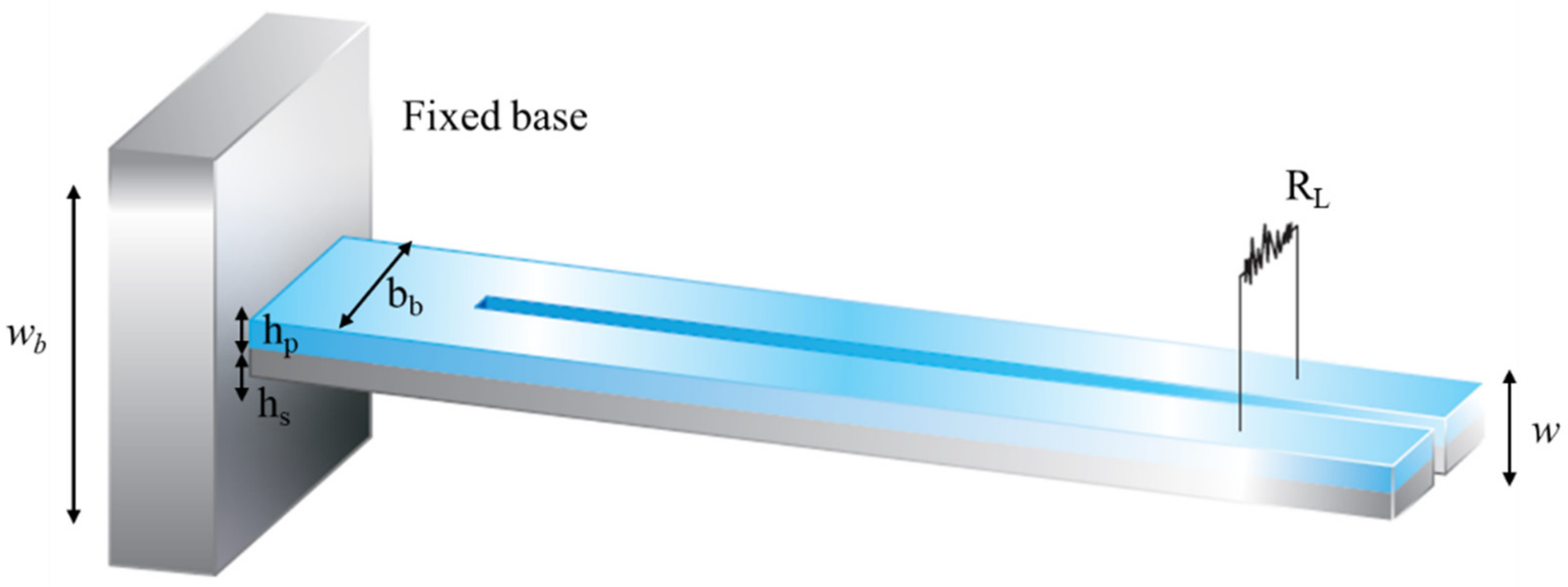
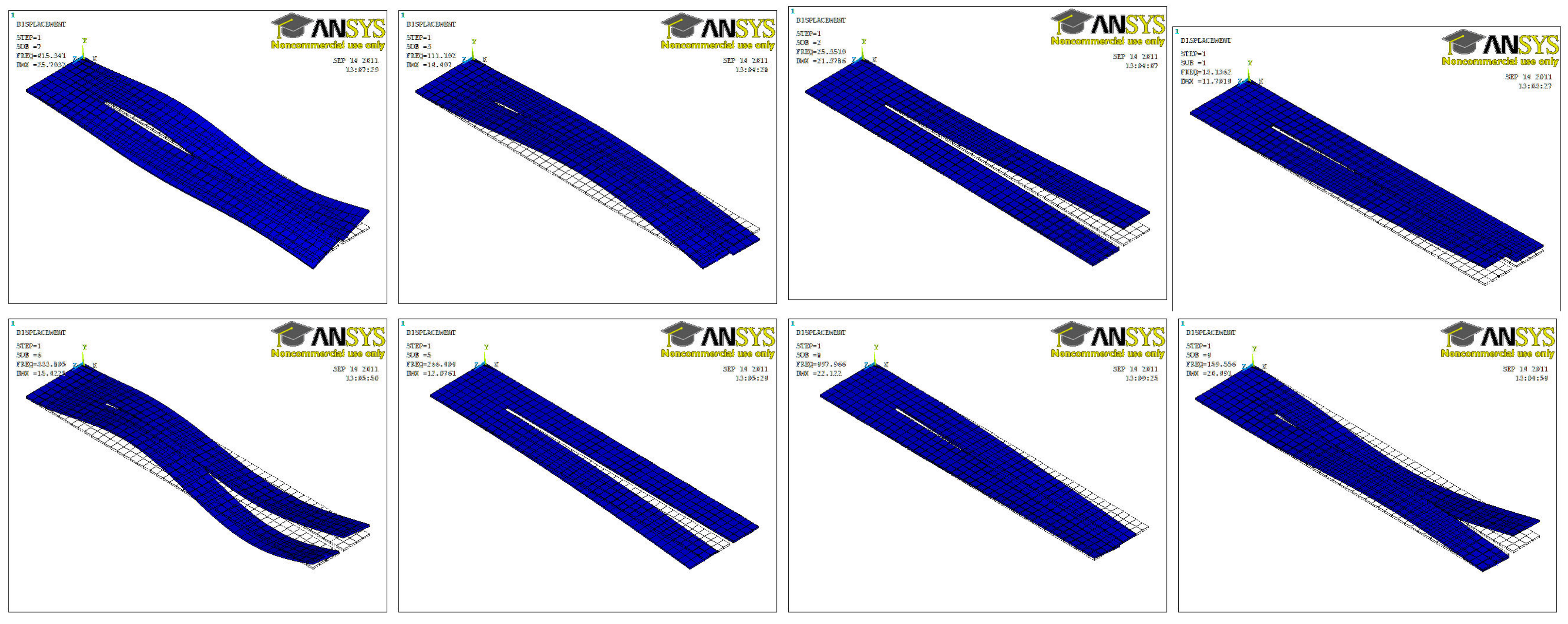


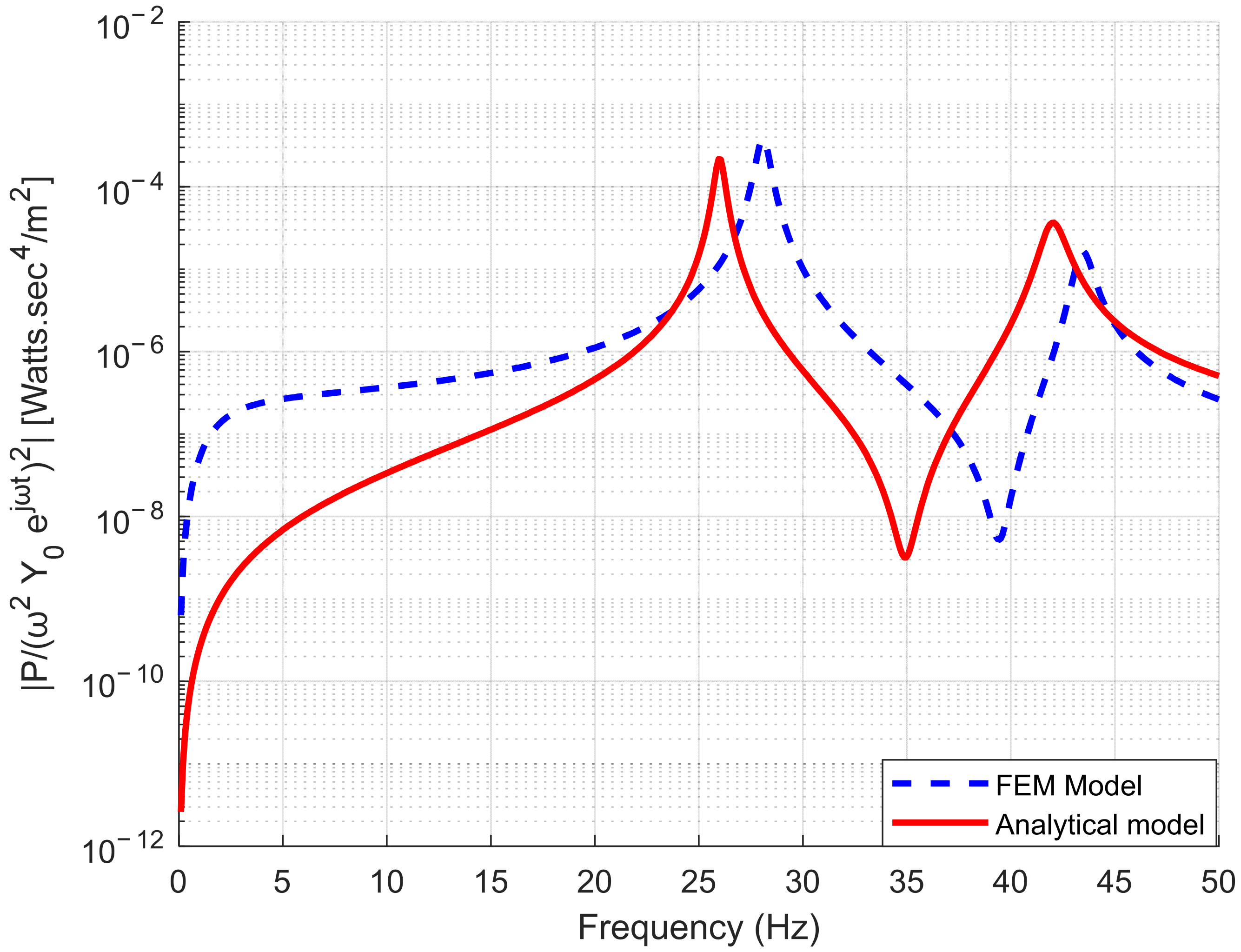

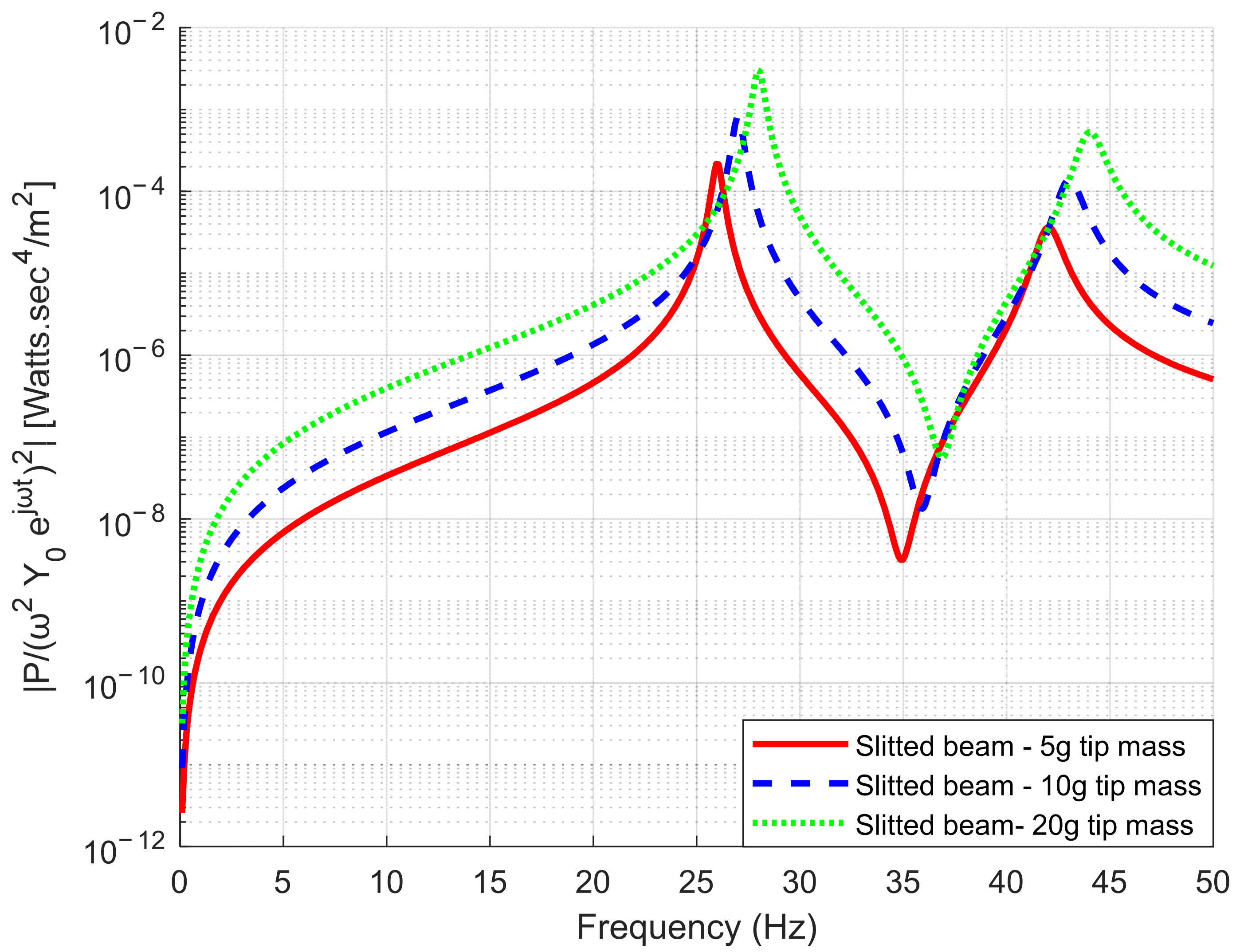
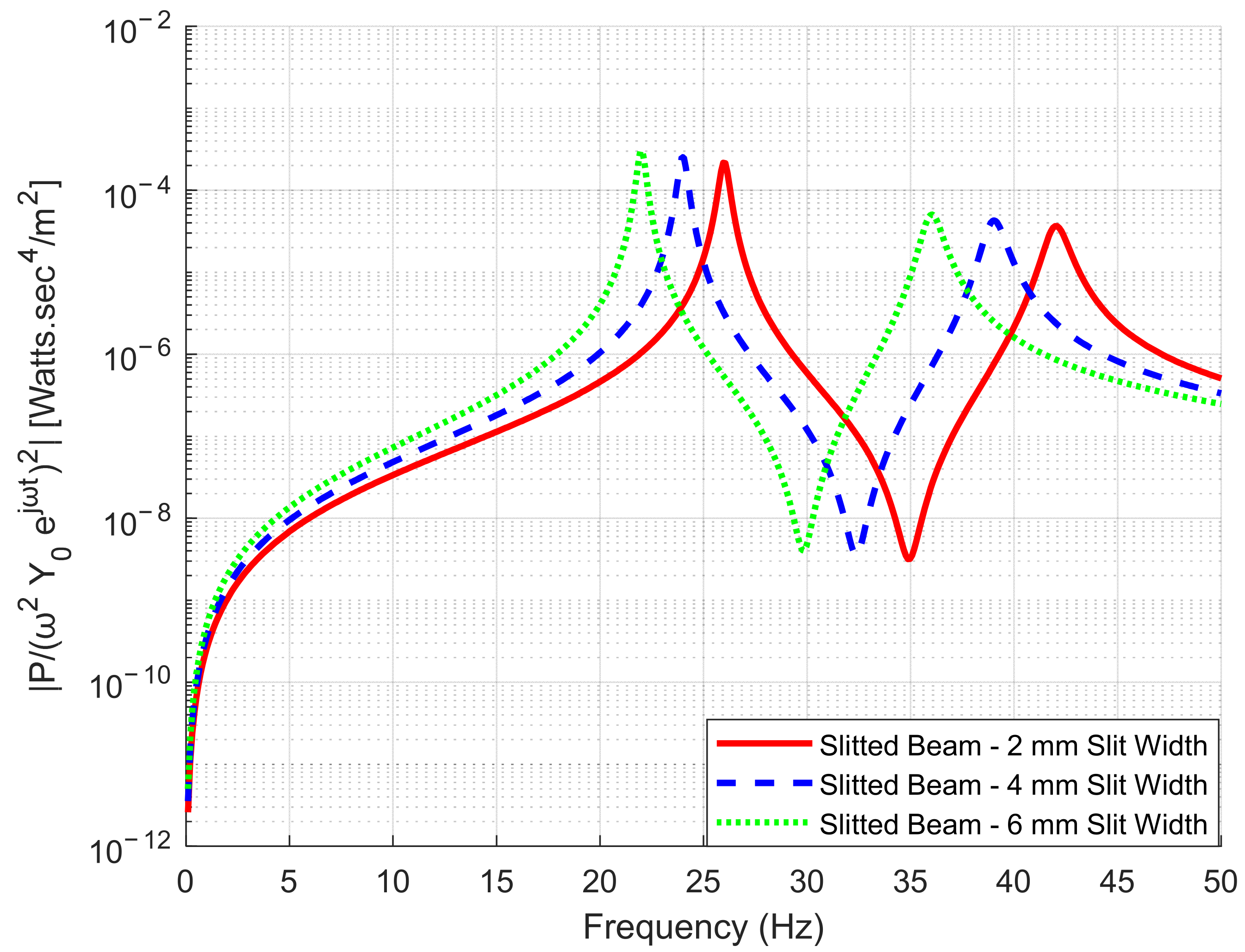
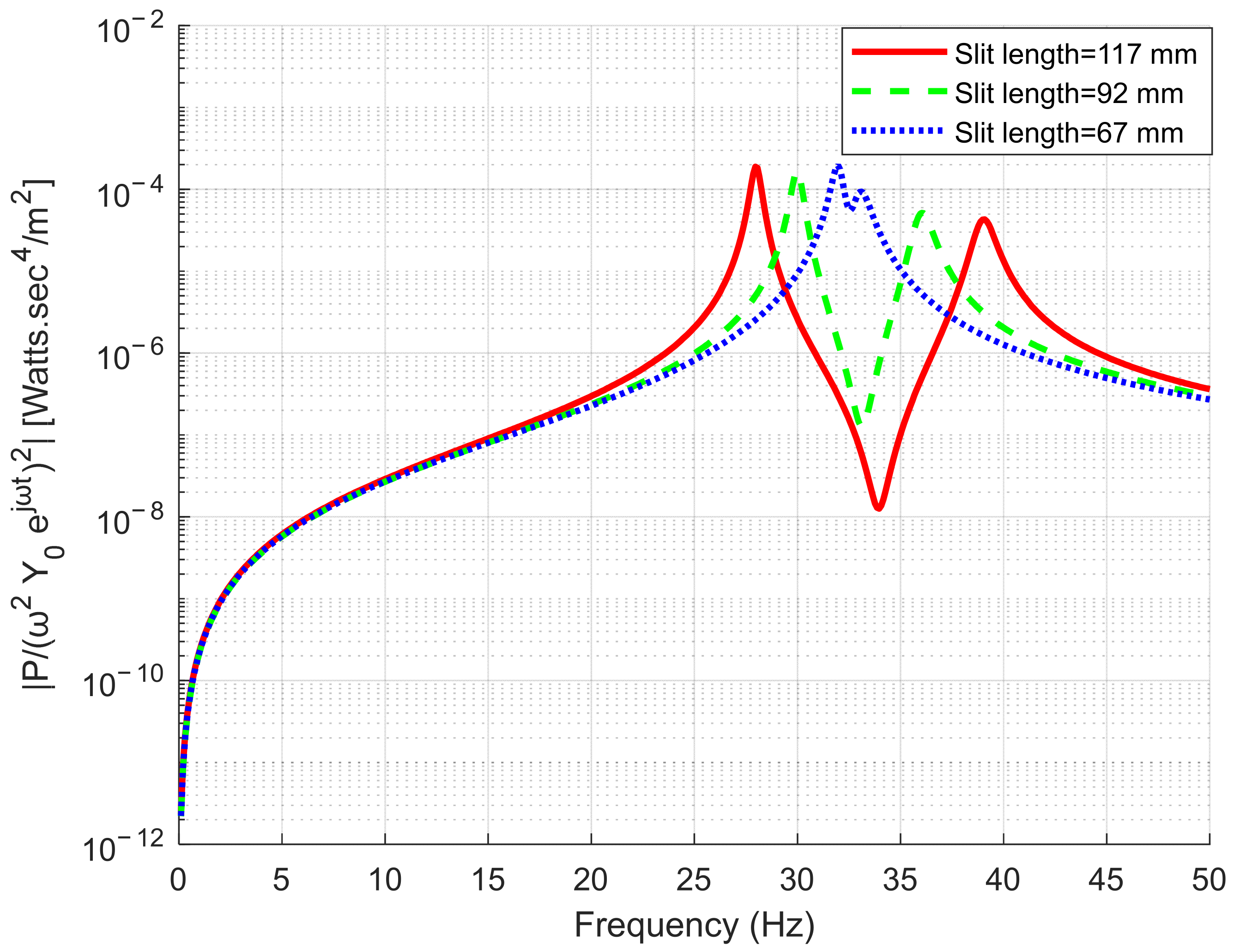
| Property | Value |
|---|---|
| Beam Length | 142 mm |
| Substructure Thickness hs | 0.7 mm |
| Piezo Thickness | 0.66 mm |
| Beam Width | 28 mm |
| Slit Length | 92 mm |
| Slit Width | 2 mm |
| Load Resistance | 1 × 104 Ω |
| Tip Mass (m1) | 5 g |
| Tip Mass (m2) | 0 |
Disclaimer/Publisher’s Note: The statements, opinions and data contained in all publications are solely those of the individual author(s) and contributor(s) and not of MDPI and/or the editor(s). MDPI and/or the editor(s) disclaim responsibility for any injury to people or property resulting from any ideas, methods, instructions or products referred to in the content. |
© 2024 by the authors. Licensee MDPI, Basel, Switzerland. This article is an open access article distributed under the terms and conditions of the Creative Commons Attribution (CC BY) license (https://creativecommons.org/licenses/by/4.0/).
Share and Cite
Almokmesh, S.F.; Alzuwayer, B.B.; Almutairi, A.S.; Alhashem, A. Dynamic Analysis and Energy Harvesting Potential of Slitted Cantilever Beam Fitted with Piezoelectric Transducer. Appl. Sci. 2024, 14, 8758. https://doi.org/10.3390/app14198758
Almokmesh SF, Alzuwayer BB, Almutairi AS, Alhashem A. Dynamic Analysis and Energy Harvesting Potential of Slitted Cantilever Beam Fitted with Piezoelectric Transducer. Applied Sciences. 2024; 14(19):8758. https://doi.org/10.3390/app14198758
Chicago/Turabian StyleAlmokmesh, Saad F., Bashar B. Alzuwayer, Abdulrahman S. Almutairi, and Abdulwahab Alhashem. 2024. "Dynamic Analysis and Energy Harvesting Potential of Slitted Cantilever Beam Fitted with Piezoelectric Transducer" Applied Sciences 14, no. 19: 8758. https://doi.org/10.3390/app14198758






